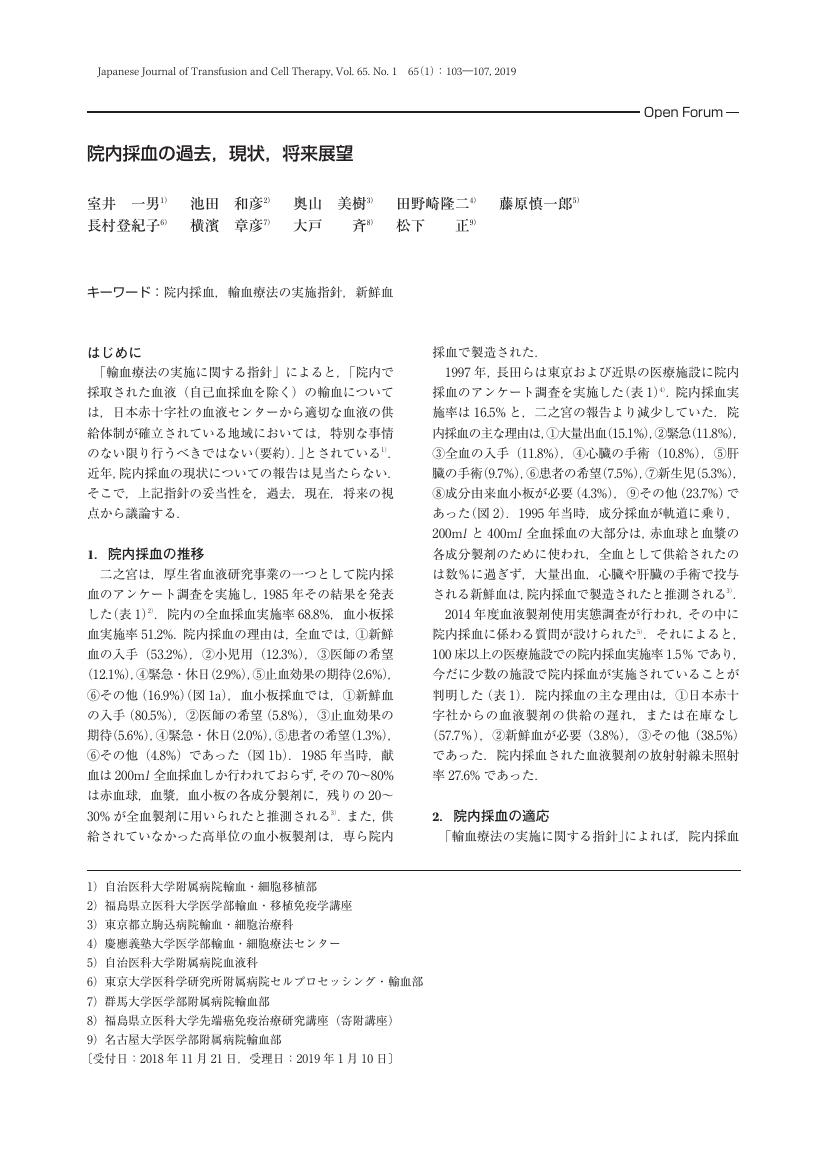4 0 0 0 OA 血縁者間の輸血によって輸血後移植片対宿主病を起こすリスクについて
- 著者
- 安田 広康 野口 まゆみ 遠山 ゆり子 大戸 斉 阿部 力哉
- 出版者
- 一般社団法人 日本輸血・細胞治療学会
- 雑誌
- 日本輸血学会雑誌 (ISSN:05461448)
- 巻号頁・発行日
- vol.38, no.5, pp.596-600, 1992-11-15 (Released:2010-03-12)
- 参考文献数
- 21
Transfusion-associated graft-versus-host disease (TA-GVHD) was described as occurring after nonirradiated blood tranfusion not only in immunosuppressed but also in immunocompetent recipients who share one HLA haplotype with HLA-homozygous blood donors.From the distribution of 1% or more frequencies of HLA-A, -B, -C, -DR, -DQ haplotypes obtained at the 11th International Histocompatibility Workshop (1991), using the fomulae of Kanter, we tried to calculate the potential risk of TA-GVHD as a result of directed donations from relatives in the Japanese and other ethnic groups.The Japanese have the greatest risk of TA-GVHD than any other populations because are more homogeneous in HLA and have a common haplotype: A24-CBL-Bw52-DRw15-DQw1 (7.5%).Of noteworthing, the risk of transfusion of HLA-homozygotes to heterozygotes among 1st-degree relatives in the Japanese was 4.7-folds compared with that of transfusion in the U. S. A. population. And, the risk of TA-GVHD among the Japanese unrelated was near to that of transufusion among the French first degree relatives.Therefore, we recommend that donations of blood components from recipient's relatives should be irradiated essentially, and as possible even from unrelated donors in the Japanese population.
2 0 0 0 OA 院内採血の過去,現状,将来展望
- 著者
- 室井 一男 池田 和彦 奥山 美樹 田野崎 隆二 藤原 慎一郎 長村 登紀子 横濱 章彦 大戸 斉 松下 正
- 出版者
- 一般社団法人 日本輸血・細胞治療学会
- 雑誌
- 日本輸血細胞治療学会誌 (ISSN:18813011)
- 巻号頁・発行日
- vol.65, no.1, pp.103-107, 2019-02-28 (Released:2019-03-18)
- 参考文献数
- 20
- 被引用文献数
- 1
2 0 0 0 OA 複合災害被災者の幸福度・精神的健康に影響を与える要因の検討
- 著者
- 竹林(兼子) 唯 大類 真嗣 中島 聡美 桃井 真帆 伊藤 亜希子 前田 正治 安村 誠司 大戸 斉
- 出版者
- 一般社団法人 日本認知・行動療法学会
- 雑誌
- 日本認知・行動療法学会大会プログラム・抄録集 第44回大会 (ISSN:24333050)
- 巻号頁・発行日
- pp.356-357, 2018-10-26 (Released:2021-05-18)
2 0 0 0 OA 高頻度抗原KANNOに対する同種抗体の血清学的性状と臨床的意義
- 著者
- 川畑 絹代 安田 広康 土田 秀明 伊藤 正一 菊地 正輝 常山 初江 内川 誠 大戸 斉
- 出版者
- 一般社団法人 日本輸血・細胞治療学会
- 雑誌
- 日本輸血細胞治療学会誌 (ISSN:18813011)
- 巻号頁・発行日
- vol.57, no.6, pp.478-483, 2011 (Released:2012-01-06)
- 参考文献数
- 12
- 被引用文献数
- 1 1
抗KANNOは1991年に福島医大病院で遭遇した高頻度抗原に対する抗体で,既知の抗体にはその反応性が一致するものが無かった.発端者に因み,この抗体を抗KANNO,対応抗原をKANNO抗原と名付けた.KANNO抗原発見に関わった福島医大病院2症例と山形県および宮城県赤十字血液センターで同定した抗KANNO 12例,計14例について反応性,臨床的意義を検討した. 抗KANNOを保有する14例のうち13例が妊娠歴のある女性であり,輸血よりも妊娠によって産生されやすい抗体であると考えられる.抗KANNOは高力価低親和性(HTLA)抗体の特徴を示し,類似した反応性を持つ抗JMHとは,AET処理赤血球と反応する点で鑑別できる.現在まで,抗KANNOによる溶血性輸血副作用(HTR)や胎児・新生児溶血性疾患(HDFN)の報告はなく臨床的意義は低いと考えられるが,さらに症例を蓄積する必要がある.
1 0 0 0 血小板製剤による敗血症の予防と対応策に関する手引き
- 著者
- 大戸 斉 高松 純樹 浅井 隆善 佐竹 正博 宮田 茂樹 山口 一成 大坪 寛子
- 雑誌
- 日本輸血細胞治療学会誌 = Japanese journal of transfusion and cell therapy (ISSN:18813011)
- 巻号頁・発行日
- vol.54, no.3, pp.419-421, 2008-06-20
1 0 0 0 OA 輸血医療における最近の進歩:特に白血球除去フィルター関連の進化
- 著者
- 大戸 斉
- 出版者
- 一般社団法人 日本内科学会
- 雑誌
- 日本内科学会雑誌 (ISSN:00215384)
- 巻号頁・発行日
- vol.103, no.7, pp.1706-1711, 2014-07-10 (Released:2015-07-10)
- 参考文献数
- 14
Aggregate除去から出発した白血球除去フィルターは進化し,輸血血液の白血球の99.99%以上と血小板の90%以上を除去する.白血球と血小板の混入を最少にすることで,大量輸血患者の多発血栓,輸血発熱反応,HLA抗原感作,病原体(CMV,HTLV,Yersinia菌)感染を防いでいる.輸血後GVHD予防目的に現在実施されている放射線照射を高性能フィルターは代替できる可能性がある.白血球除去による輸血関連免疫修飾への防止効果について結論は出ていない.血小板製剤用白血球除去フィルターを用いた血小板と遠心法によって白血球数低減した血小板では残存白血球数に差がないが,サブセットは異なり,遠心法では単球比率が高い.このため,HLA抗原感作に関与している可能性があり,検証が必要である.prion除去能を併せ持つ白血球除去フィルターが開発されているが,臨床への導入は未だである.
1 0 0 0 高頻度抗原KANNOに対する同種抗体の血清学的性状と臨床的意義
- 著者
- 川畑 絹代 安田 広康 土田 秀明 伊藤 正一 菊地 正輝 常山 初江 内川 誠 大戸 斉
- 出版者
- 一般社団法人 日本輸血・細胞治療学会
- 雑誌
- 日本輸血細胞治療学会誌 = Japanese journal of transfusion and cell therapy (ISSN:18813011)
- 巻号頁・発行日
- vol.57, no.6, pp.478-483, 2011-12-15
- 参考文献数
- 12
- 被引用文献数
- 1
抗KANNOは1991年に福島医大病院で遭遇した高頻度抗原に対する抗体で,既知の抗体にはその反応性が一致するものが無かった.発端者に因み,この抗体を抗KANNO,対応抗原をKANNO抗原と名付けた.KANNO抗原発見に関わった福島医大病院2症例と山形県および宮城県赤十字血液センターで同定した抗KANNO 12例,計14例について反応性,臨床的意義を検討した.<br> 抗KANNOを保有する14例のうち13例が妊娠歴のある女性であり,輸血よりも妊娠によって産生されやすい抗体であると考えられる.抗KANNOは高力価低親和性(HTLA)抗体の特徴を示し,類似した反応性を持つ抗JMHとは,AET処理赤血球と反応する点で鑑別できる.現在まで,抗KANNOによる溶血性輸血副作用(HTR)や胎児・新生児溶血性疾患(HDFN)の報告はなく臨床的意義は低いと考えられるが,さらに症例を蓄積する必要がある.<br>
- 著者
- 稲葉 頌一 大戸 斉 柴田 洋一 坂本 久浩 高橋 孝喜 十字 猛夫 前田 義章
- 出版者
- 一般社団法人 日本輸血・細胞治療学会
- 雑誌
- 日本輸血学会雑誌 (ISSN:05461448)
- 巻号頁・発行日
- vol.40, no.1, pp.1-13, 1994-01-25 (Released:2010-03-12)
- 参考文献数
- 9
Sixty-six patients who succeeded in storing a sufficient volume of autologous blood (mean±SD; 1097±452ml) using KL-3R3 solution contained in blood bags before elective surgery were included in this study, a five week phase 3 clinical trial of the whole blood preservative solution KL-3R3, commonly known as CPDA-1 (citrate phosphate dextrose adenine) solution. The mean time required for sufficient storage of autologous blood was 23.4±6.9 days, with 40 of the 66 (60.6%) requiring more than 21 days, a period of time that would have resulted in time expiration had we used the citrate-phosphate-dextrose (CPD) or acid-citrate-dextrose (ACD) solution bags which are presently commercially available. Sixty of the 66 patients (90.9%) completed their operations using only autologous blood units. After eliminating three patients who were administered recombinant erythropoietin, the efficacy of KL-3R3 was evaluated as effective in 61 (96.8%) of the 63 patients evaluated (markedly effective 57 (86.4%) and effective 4 (6.1%). Furthermore, in 48 of 56 patients (85.7%), in whom we were able to measure the autologous blood recovery rate after 24 hours of transfusion were estimated effective (markedly effective 29 (51.8%) and effective 19 (33.9%)). In sixty-three patients who had hematological and biochemical laboratory data, vital signs, and urinary data recorded both before and after receiving autologous blood units. RBC counts and hemoglobin levels and platelets counts decreased, and WBC counts increased after returning autologous blood at operation, changes observed commonly under surgical stress. Hemolysis markers such as GPT, indirect bilirubin, and LDH were slightly increased the day after operation, but returned to normal the second day after operation. Other data moved within normal limits expect urine occult blood. Hematuria was observed immediately after transfusion of autologous blood units, but this finding was observed transiently (the first day after transfusion 45.7% and the second day 13.3%). The safety was evaluated in sixty-five patients' blood bags by sight observations and bacterial culture tests, and no abnormal findings or bacterial propagation were detected. One patient was excluded from the safety evaluation because he was operated on within a week of initial predeposition. Two-hundred-thirty-eight KL-3R3 preserved blood bags were transfused in the 66 patients, in one (1/238, 0.4%) which had be discarded because of a large clot formation. In sixty-one patients, both the efficacy and the safety tests of KL-3R3 were rated for usefulness, with all 61 confirmed useful. The laboratory data of the 26 patients whose autologous blood were used within 21 days and the 40 patients whose autologous blood contained at least one unit that exceeded 21 days preservation was compared, with no significant differences observed.Our results confirmed that, in clinical trial of KL-3R3 preserved autologous blood units, all the criteria of effectiveness, safety and usefulness were satisfied.

